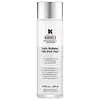What's inside
What's inside
 Key Ingredients
Key Ingredients

 Benefits
Benefits

 Concerns
Concerns

 Ingredients Side-by-side
Ingredients Side-by-side

Water
Skin ConditioningHydrogenated Polydecene
EmollientCaprylic/Capric Triglyceride
MaskingSqualane
EmollientCarthamus Tinctorius Seed Oil
Masking1,2-Hexanediol
Skin ConditioningPEG-6 Caprylic/Capric Glycerides
EmulsifyingPEG-40 Glyceryl Cocoate
EmulsifyingPhenoxyethanol
PreservativeSodium Coceth Sulfate
CleansingCapryloyl Salicylic Acid
ExfoliatingTromethamine
BufferingEthylhexylglycerin
Skin ConditioningCitrus Nobilis Peel Oil
MaskingAdenosine
Skin ConditioningLimonene
PerfumingCaprylyl Glycol
EmollientAnthemis Nobilis Flower Oil
MaskingCupressus Sempervirens Leaf/Nut/Stem Oil
EmollientPrunus Amygdalus Dulcis Seed Extract
Skin ConditioningBenzyl Alcohol
PerfumingXanthan Gum
EmulsifyingSilybum Marianum Extract
Skin ConditioningTocopherol
AntioxidantDehydroacetic Acid
PreservativeLactic Acid
BufferingWater, Hydrogenated Polydecene, Caprylic/Capric Triglyceride, Squalane, Carthamus Tinctorius Seed Oil, 1,2-Hexanediol, PEG-6 Caprylic/Capric Glycerides, PEG-40 Glyceryl Cocoate, Phenoxyethanol, Sodium Coceth Sulfate, Capryloyl Salicylic Acid, Tromethamine, Ethylhexylglycerin, Citrus Nobilis Peel Oil, Adenosine, Limonene, Caprylyl Glycol, Anthemis Nobilis Flower Oil, Cupressus Sempervirens Leaf/Nut/Stem Oil, Prunus Amygdalus Dulcis Seed Extract, Benzyl Alcohol, Xanthan Gum, Silybum Marianum Extract, Tocopherol, Dehydroacetic Acid, Lactic Acid
Water
Skin ConditioningPropanediol
SolventGluconolactone
Skin ConditioningGlycerin
HumectantButylene Glycol
Humectant1,2-Hexanediol
Skin ConditioningArginine
MaskingHydrogenated Lecithin
EmulsifyingCaprylic/Capric Triglyceride
MaskingPotassium Cetyl Phosphate
EmulsifyingSimmondsia Chinensis Seed Oil
EmollientSalicylic Acid
MaskingHydroxyacetophenone
AntioxidantAllantoin
Skin ConditioningDipotassium Glycyrrhizate
HumectantSqualane
EmollientVolcanic Ash Extract
Skin ConditioningTrehalose
HumectantHydroxyethylcellulose
Emulsion StabilisingSea Water
HumectantArtemisia Princeps Leaf Extract
Skin ConditioningSodium Hyaluronate
HumectantJuniperus Mexicana Oil
MaskingRosmarinus Officinalis Leaf Oil
MaskingAmyris Balsamifera Bark Oil
MaskingAnthemis Nobilis Flower Oil
MaskingEthyl Hexanediol
SolventWater, Propanediol, Gluconolactone, Glycerin, Butylene Glycol, 1,2-Hexanediol, Arginine, Hydrogenated Lecithin, Caprylic/Capric Triglyceride, Potassium Cetyl Phosphate, Simmondsia Chinensis Seed Oil, Salicylic Acid, Hydroxyacetophenone, Allantoin, Dipotassium Glycyrrhizate, Squalane, Volcanic Ash Extract, Trehalose, Hydroxyethylcellulose, Sea Water, Artemisia Princeps Leaf Extract, Sodium Hyaluronate, Juniperus Mexicana Oil, Rosmarinus Officinalis Leaf Oil, Amyris Balsamifera Bark Oil, Anthemis Nobilis Flower Oil, Ethyl Hexanediol
 Reviews
Reviews

Alternatives
Ingredients Explained
These ingredients are found in both products.
Ingredients higher up in an ingredient list are typically present in a larger amount.
1,2-Hexanediol is a synthetic liquid and another multi-functional powerhouse.
It is a:
- Humectant, drawing moisture into the skin
- Emollient, helping to soften skin
- Solvent, dispersing and stabilizing formulas
- Preservative booster, enhancing the antimicrobial activity of other preservatives
This oil is created by distilling the dried flower heads of the Roman Chamomile flower.
Chamomile is rich in antioxidants and has anti-inflammatory properties. Several compounds found in chamomile help with soothing, such as bisbolol.
This ingredient is an emollient, solvent, and texture enhancer. It is considered a skin-softener by helping the skin prevent moisture loss.
It helps thicken a product's formula and makes it easier to spread by dissolving clumping compounds.
Caprylic Triglyceride is made by combining glycerin with coconut oil, forming a clear liquid.
While there is an assumption Caprylic Triglyceride can clog pores due to it being derived from coconut oil, there is no research supporting this.
Learn more about Caprylic/Capric TriglycerideSqualane is an emollient that helps the skin hold onto moisture. It's an oily liquid that occurs naturally in certain types of fish and plant oils.
Because squalane boosts hydration in the skin, it also comes with plenty of benefits: it is an antioxidant and can help fight free radicals and skin damage. Squalane is also found to have a detoxifying effect when applied.
Squalane comes from squalene, which occurs naturally within the sebum of our skin. It is one of the oils our skin produces to keep itself hydrated. Squalane is the hydrogenated version of squalene and has a longer shelf life.
Research shows that squalane is non-irritating (even at 100% concentration).
In general, it's a fantastic ingredient. It does a great job at hydrating the skin, and it's suitable for those with sensitive skin.
The source of squalane may impact malassezia / fungal acne. This is because olive oil derived squalane can contain impurities such as fatty acids and plant waxes. Sugarcane derived squalane is recommended for anyone with malassezia concerns.
Is squalane vegan?
This depends on the source. Squalane can be derived from both plants and animals. Most squalane used in skincare comes from plants.
Please note: the source of squalane is only known if disclosed by the brand. We recommend reaching out to the brand if you have any questions about their squalane.
Read more about squalene with an "e".
Is squalane an oil?
Squalane is often called an oil, but it’s technically not; it’s a hydrocarbon, meaning it’s only made of carbon and hydrogen, unlike true oils which are triglycerides made of fatty acids and glycerol.
The term “oil-free” isn’t regulated, so companies can define it however they want. Some exclude all oils, while others just avoid mineral oil or comedogenic oils.
While some people avoid oils thinking they cause breakouts, the right kind of oil (or oil-like ingredient like squalane) can actually help balance and hydrate your skin. It’s worth testing out simple oils or squalane to see what works best for your skin.
Learn more about SqualaneWater. It's the most common cosmetic ingredient of all. You'll usually see it at the top of ingredient lists, meaning that it makes up the largest part of the product.
So why is it so popular? Water most often acts as a solvent - this means that it helps dissolve other ingredients into the formulation.
You'll also recognize water as that liquid we all need to stay alive. If you see this, drink a glass of water. Stay hydrated!
Learn more about Water